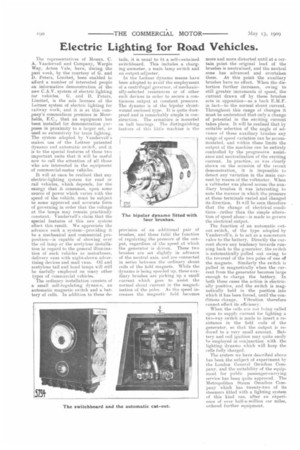Electric Lighting for Road Vehicles.
Page 4

If you've noticed an error in this article please click here to report it so we can fix it.
The representatives of 11Lessrs. C. A. Vandervell and Company, Warple Way, Acton Vale, have, during the past week, by the courtesy of G. and 1). Peters, Limited, been enabled to afford a number of interested people an informative demonstration of the new C.A.V. system of electric lighting for vehicles. G. and D. Peters, Limited, is the sole licensee of the Leitner system of electric lighting for railway work, and it is at this company's commodious premises in Moorfields, EC., that an equipment has been installed for demonstration purposes in proximity to a larger set, as used so extensively for train lighting. The system adopted by Vandervell's makes use of the Leitner patented dynamo and automatic switch, and it is to the special features of these two important units that it will be useful now to call the attention of all those who are interested in the equipment of commercial-motor vehicles.
It will at once be realised that any electric-lighting system for road or rail vehicles, which depends, for the energy that it consumes, upon sonic source of power which varies with the speed of the .vehicle, must be subject to some approved and accurate form of governing in order that the voltage at the lamps may remain practically constant. Vandervell's claim that the special features of this new system effect this result. We appreciate the advance such a system—providing it be a mechanical and commercial proposition—is capable of showing over the oil lamp or the acetylene installation in regard to the general illumination of such vehicles as motorbuses, delivery vans with night-shown advertising devices and mail vans. Oil and acetylene tail and head lamps wilt still be usefully employed on many other types of eommercial vehicles.
The ordinary installation consists of a small self-regulating dynamo, an automatic magnetic switch and a battery of cells. In addition to these de tails, it is usual to fit a self-contained switchboard. This includes a charging ammeter, a main lamp switch and
an on adjuster.
In the Leitner dynamo means have been adopted to avoid the employment of a centrifugal governor, of mechanically-selected resistances or of other such devices in order to secure a continuous output at constant pressure. The dynamo is of the bipolar shuntwound enclosed type. It is quite dustproof and is remarkably simple in construction. The armature is mounted on ball bearings. The distinguishing feature of this little machine is the provision of an additional pair of brushes, aud these fulfil the function of regulating the pressure of the output, regardless of the speed at which the generator is driven. These two brushes are set slightly in advance of the neutral axis. and are connected in series between the ordinary shunt coils of the held magnets. While the dynamo is being speeded up, these auxiliary brushes are picking up a small current which goes to assist the normal shunt current in the magnetisation of the poles. As the speed increases the magnetic field becomes
more and more distorted until at a certain point the original lead of the brushes is neutralised, and the neutral zone has advanced and overtaken them. At this point the auxiliary brushes have no effect. When the distortion further increases, owing to still greater increments of speed, the current drawn off by these brushes acts in opposition—as a back E.M.F. in fact—to the normal shunt current. Throughout this range of changes it must be understood that only a change of potential in the exciting current takes place. It will be realised that by suitable selection of the angle of advance of these auxiliary brushes any range of speed variation can be accommodated, and within these limits the output of the machine can be entirely controlled by the progressive assistance and neutralisation of the exciting current. In practice, as was clearly shown on the occasion of the recent demonstration, it is impossible to detect any variation in the main current by means of the voltmeter. When a voltmeter was placed across the auxiliary brushes it was interesting to note the manner in which the pressure at these terminals varied and changed its direction. It will be seen therefore that the change of electrical conditions—rather than the simple alteration of speed alone—is made to govern the electrical output.
The function of an automatic cutout switch, of the type adopted by Vandervell's, is to act as a non-return valve to the battery. Directly the current shows any tendency towards running back to the pnerator, the switch is automatically pulled out owing to the reversal of the two poles of one of the magnets. Similarly the switch is pulled in magnetically when the current from the generator becomes large enough to charge the battery. In both these cases the action is electrically positive, and the switch is magnetically held in the position into which it has been forced, until the conditions change. Vibration therefore cannot effect its effleiency.
When the cells are not being called upon to supply current for lighting a two-way switch is made to insert a resistance in the field coils of the generator, so that the output is reduced to a very small amount. Battery and coil ignition may quite easily be employed in conjunction with the lighting dynamo which will keep the cells fully charged.
The system we have described above has been the subject of experiment by the London General Omnibus Company. and the suitability of the equipment for public passenger-carrying service has been quite approved. The Metropolitan Steam Omnibus Company which has twenty-two of its steamers fitted with a lighting system of this kind nas, after an experience of over half-a-million ear miles, ordered further equipment.






















